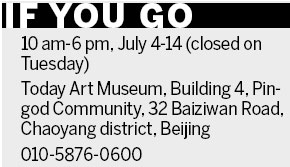Social life, lonely art
Updated: 2013-07-04 07:52
By Xu Jingxi (China Daily)
|
||||||||
|
Staff members from the Guangdong Museum of Art arrange an exhibit of He Duoling's paintings at his solo show in Guangzhou. Photos provided to China Daily |
|
He Duoling keeps a lower profile as a painter and a professor in his hometown Chengdu. |
|
Spring Winds Have Awoken, oil on canvas by He Duoling. |
He Duoling's outgoing and fun-loving personality exists in sharp contrast to his estranged and sad paintings. Xu Jingxi reports in Guangzhou.
He Duoling's paintings are lonely and sad - the exact opposite of his real life.
The 65-year-old adores parties.
After setting up his solo show in Guangzhou on June 17, he stayed up drinking, eating and cracking jokes with his students and friends until 1 am.
Such revelry stands in stark contrast to the work at his recent solo show in Guangdong's provincial capital Guangzhou and his Beijing show with painter Xiao Kegang from July 4 to 14.
His works depict a woman wearing rabbit ears, whose large eyes are filled with fear as she hides in the woods, flees downhill and attempts to fly - as if soaring away from a desperate life.

Haze envelops his paintings' flowers, the colors of which dribble down the canvas, as if weeping.
The Beijing show will debut his most recent pieces from his Flowers and Wild Garden series.
"I'm still best known for my paintings of women, but I long ago expanded the themes," He says.
"In Flowers, I explored the application of Chinese ink-painting techniques to oils, rendering flowers with a blurred background. Western oil painting usually presents flowers in a more realistic way, while mine are more spiritual."
They perhaps show the spiritual distinction between He's daily life and artistic affairs.
"When I paint, I enter a quiet and lonely world parallel to real life," He says.
"My life can be intense, but the world in which my art is created is quiet and behind a shut door."
He is only introverted when alone, he explains.
"I love hanging out with people only when we're at ease, talking about art and life. I avoid trapping myself in big occasions where I need to socialize with officials and businesspeople."
This may explain why He, who made a name for himself in 1982 when his Spring Winds Have Awoken painting was exhibited at the Spring Salon Exhibition in the Louvre in Paris and later collected by the National Art Museum of China, has left the spotlight to his Sichuan Fine Arts Institute schoolmates.
Oil painter Zhou Chunya, who graduated with He in 1982, tops the latest Hurun Art List released in April with $76 million in 2012 auction sales. He ranked 44th with $7.8 million.
He's classmate Luo Zhongli is the institute's president, the China Artists Association's vice-president and a National People's Congress deputy. He keeps a lower profile as a painter and a professor at the Chengdu Academy of Fine Arts under the Sichuan Conservatory of Music.
He says he has no hard feelings and admires his schoolmates' ability to become successful businesspeople and administrators, while actively creating art.
He has declined opportunities to become an institute's director, he says.
"I hate meetings," he says.

"I fear responsibility and interfering with others. I'd rather leave them alone and have them do the same to me."
He explains that assuming the position would offer perks, such as higher status and auction prices for his works.
"But these would come at the cost of my leisurely lifestyle."
He usually sleeps through the morning and drives to his studio in Chengdu's suburban Blue Roof Art District in the afternoon.
Young artists frequent his studio to enjoy tea in the garden, watch art-house films projected on the wall, compete in He's badminton club or view football while sipping cold beer in the swimming pool.
He has stayed in Chengdu while many of the city's artists have moved to Beijing, so he can remain aloof from the capital's noisy art scene to focus on creation, he says.
"Beijing's artists form cliques, and daily commercial activities bombard the art districts," He says.
"Chengdu's artists can enjoy peace of mind. They're not forced to socialize too much or experience hidden strife. Different generations of artists here coexist peacefully rather than despise one another as often happens in other cities. Youth respect elders, while elders help youth."
He's 27-year-old student Zhu Keran says she appreciates that he helps up-and-coming artists without reservation.
She learned from him that "art doesn't only come from pain" but also from being outgoing as a person and unrestricted as a creator.
"He takes us to exhibitions, and introduces us to curators and dealers," says Zhu, who followed her teacher to Guangzhou.
"He uses his fame to stage joint shows with his students. I'm lucky to have such a good teacher."
He staged an exhibition with 10 students in Shanghai in 2011 and another with 10 students in Beijing last year.
He says it's difficult for young artists to match the success of his generation - the first group of students admitted to his school after the "cultural revolution" (1966-76).
They are now painting's bigwigs - He, Zhou, Luo and Zhang Xiaogang. Zhang ranks 13th and Luo is 18th on the Hurun Art List that Zhou tops.
"China's door had just been thrown open to the world when we went to the institute," He says.
"The numerous schools and techniques of Western Classical, Modern and Contemporary genres rushed in and shocked us. We'd had a rigidly traditional education and homogenous society during the 'cultural revolution'.
"What we presented after learning from Western art was eye-opening to the public. That enabled us to stage a great coup."
He recalls being stunned by the extremely realistic depiction of grass in American painter Andrew Wyeth's Christina's World, when he first saw it in a magazine in 1981. He decided to use the same technique in his master's degree capstone work, Spring Winds Have Awoken.

Having worked on the desolate grasslands of Sichuan province's Liangshan Yi autonomous prefecture for three years during the "cultural revolution", the painter used his brush to convey his deep feelings about the land.
The painting made a stir, and people interpreted the "spring winds" as symbolizing China's reform and opening-up policy.
"(The 'cultural revolution') was a tragedy of our time but created later opportunities," He says.
He says that while today's young artists don't have a disruptive social transition to serve as a stage for wowing the public, they enjoy a relatively mature art market.
Chinese art exploded at the turn of this century, when overseas collectors made high bids for works by famous contemporary Chinese artists, including He.
Lists ranking artists according to their works' prices have also developed in the country in the past five years.
"Although China's art market still faces problems, such as auction fraud, we've built a business chain linking painters, galleries and auction houses," He says.
"And our market connects to the global market."
He used to vehemently oppose art's commodification. But his attitude has softened with age.
"Artists can make a living selling their paintings," he says.
"The market also exposes their works to audiences. Artists can't hole themselves up and not let others see their creations.
"An authentic artist is someone whose paintings have a market but doesn't create for the sake of sales."
Contact the writer at xujingxi@chinadaily.com.cn.
(China Daily USA 07/04/2013 page10)

 Ecuador finds spy mic for Assange meeting
Ecuador finds spy mic for Assange meeting
 US martial artists arrive at Shaolin Temple
US martial artists arrive at Shaolin Temple
 July 4 in Prescott: Balance of grief, patriotism
July 4 in Prescott: Balance of grief, patriotism
 Jubilant crowds celebrate after Mursi overthrown
Jubilant crowds celebrate after Mursi overthrown
 Growth slowing for services
Growth slowing for services
 Venezuela eyed as Snowden seeks asylum
Venezuela eyed as Snowden seeks asylum
 Anti-terror drill staged in Xinjiang
Anti-terror drill staged in Xinjiang
 Memorial service held for 19 Arizona firefighters
Memorial service held for 19 Arizona firefighters
Most Viewed
Editor's Picks

|

|

|

|

|

|
Today's Top News
US welcomes China's engagement in Africa
Data show shifts in US, China economies
Obama, Merkel agree talks on surveillance program
Filipino executed for drug trafficking
Obama orders US to review aid to Egypt
Snowden still in Moscow
China urges more efficient uses of fiscal funds
Egypt army topples president Morsi
US Weekly

|

|









